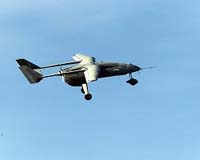| . |  |
. |
Herndon VA (SPX) Sep 04, 2009 Northrop Grumman's Hunter Unmanned Aircraft System (UAS), in use with the U.S. Army since 1996, has successfully completed testing of the new GPS-guided Viper Strike (VS) weapons system at White Sands Missile Range, N.M. GPS VS will soon deploy to theater on board Hunter in support of contingency operations. GPS VS aides the weapons guidance by providing proximity based on coordinates while maintaining pinpoint accuracy with laser guidance. While previous VS systems required the Hunter to be directly overhead, GPS VS offers the advantage of nearly six miles of stand-off range. GPS VS can also hone in on both moving and stationary targets. The MQ-5B Hunter, which is currently deployed in contingency operations, provides warfighters with state-of-the-art reconnaissance, surveillance, and target acquisition (RSTA), communications relay, signal intelligence, and weapons delivery. Hunter recently surpassed 80,000 flight hours, 53,000 of which are combat-related. "Once again, Northrop Grumman and the Army have proven just how adaptable Hunter is, which is why we call it the Army's workhorse," said Karl Purdy, Northrop Grumman Technical Services' Hunter program manager. "The addition of this improved smart munition with a proven aerial platform is just one example of Hunter's flexibility and adaptability. We are committed to working shoulder to shoulder with our valued Army customer to continue to provide our nation's warfighters with world-class ISR and signals intelligence." The RQ-5A Hunter was the Army's first fielded UAS. The MQ-5B is the next-generation Hunter, continuing a legacy of service to Army corps, division and brigade warfighters. Flying over the battlefield with its multi-mission optronic payload, the MQ-5B gathers RSTA information in real time and relays it via video link to commanders and soldiers on the ground. The MQ-5B Hunter is distinguished by its heavy fuel engines, its "wet" (fuel-carrying) extended center wing with weapons-capable hard points and a modern avionics suite. The MQ-5B Hunter system uses the Army's One System ground control station and remote video terminal. It also carries a communications relay package to extend the radio range of warfighters. A differential GPS automatic takeoff and landing system was recently fielded to the UAS Training Battalion in support of Hunter training. "For more than a dozen years the Hunter Unmanned Aircraft System has been the most versatile tool in the Army UAS inventory, undergoing continual upgrades and improvements to meet the needs of the warfighter more effectively in several theaters of war," said Col. Greg Gonzalez, Project Manager for the Army's Unmanned Aircraft Systems. "The integration of the GPS Viper Strike on the Hunter is the most recent example in a long list of rapid integration efforts made on that system to better support our soldiers in combat and give them the tools they need to succeed." The MQ-5B features a robust, fixed-wing, twin tail-boom design with redundant control systems powered by two heavy fuel engines - one engine to "push" and another to "pull" the air vehicle. Another Hunter capability is its relay mode that allows one Hunter to be controlled by another UAV at extended ranges or over terrain obstacles typical of those found in the Balkans and Afghanistan. Hunter's toughness and reliability are unmatched as it maintains an operational readiness rate over 95 percent in operational theaters. It is an ideal platform for spiral enhancements and technology refresh payloads. Recently Northrop Grumman integrated a new suite of avionics for Hunter, including upgraded flight and mission computers, an auxiliary power distribution unit, the LN-251 inertial navigation system with GPS, a downsized data link system, and an APX-118 IFF transponder. The avionics suite improves performance by reducing size, weight, and power consumption of the equipment used to control the aircraft and manage its critical subsystems. Share This Article With Planet Earth
Related Links Northrop Grumman UAV News - Suppliers and Technology
 Pakistan to make its own drones
Pakistan to make its own dronesIslamabad, Pakistan (UPI) Aug 31, 2009 Pakistan, which has been seeking drone technology from the United States, has decided to make the pilotless plane on its own for its air force. Under a program launched this month, Pakistan's domestic version of the drone or unmanned aerial vehicle to be called Falco will be made in collaboration with Selex Galileo of Italy at the Pakistan Aeronautical Complex in Kamra in Punjab ... read more |
|
| The content herein, unless otherwise known to be public domain, are Copyright 1995-2009 - SpaceDaily. AFP and UPI Wire Stories are copyright Agence France-Presse and United Press International. ESA Portal Reports are copyright European Space Agency. All NASA sourced material is public domain. Additional copyrights may apply in whole or part to other bona fide parties. Advertising does not imply endorsement,agreement or approval of any opinions, statements or information provided by SpaceDaily on any Web page published or hosted by SpaceDaily. Privacy Statement |